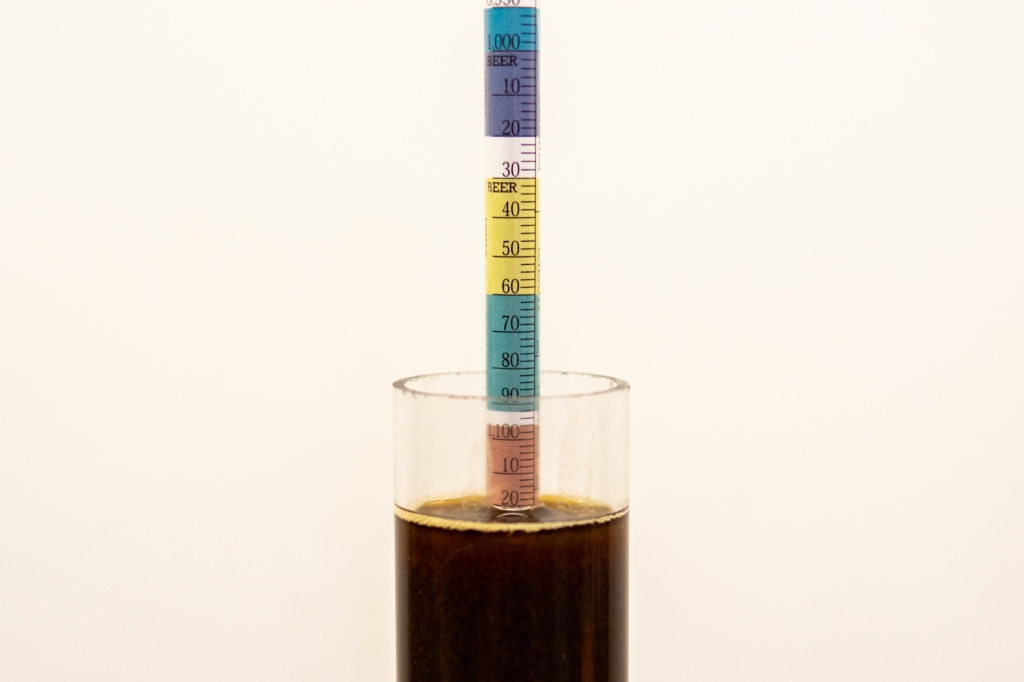Polygyle party!

“Pastry stout.” It’s a term that drives some people crazy and makes others salivate. I’ve had my fair share of disgustingly saccharine examples, but generally speaking, I lovitz. I don’t really care that beer today isn’t the same as it was 20 years ago. I like that it’s getting weirder and trying to do different stuff. If beer wants to be dessert, let it be dessert.
Today I brewed my first pastry stout. If you’re not familiar with the name, here’s the deal: pastry stouts are basically imperial stouts (meaning they’re about 9-14% ABV), but sweeter, with a thicker mouthfeel, and typically aged on lots of different adjuncts—vanilla, coconut, coffee, maple syrup, fruit, cinnamon, and myriad other spices. If you can find it in a dessert, you can probably find it in a pastry stout.
The base recipe is a bit different from a typical imperial stout. Specifically, there’s less roast and more caramel, in an effort to sweeten the wort. My recipe, cribbed heavily from this award-winner discussed on the Experimental Brewing podcast, only includes 1 pound of roasted malt in a 22.9-pound grain bill. It also includes 1.5 pounds of maltodextrin, which can’t be fermented by brewing yeast and thus boosts the thickness and apparent sweetness of the finished beer.
For this brew, I used a technique that’s new to me: a polygyle mash (aka a reiterated mash). It’s a clever way to brew a big beer with a small system, splitting the grain bill, mashing the first half in water and the second half in the wort from the first mash. I did this with BIAB, and added a couple extra steps by sparging each mash—the first with distilled water and the second with half of the combined runnings of the first mash and the first sparge.
What’s in it?
The Vitals
- Batch size: 6 gallons
- First mash: 70 minutes at 158F
- Second mash: 120 minutes at 152F
- Boil: 120 minutes
- OG: 1.121
- FG: 1.037
- ABV: 12.8%
- IBU: 60
- Efficiency: 76% pre-boil conversion, 71% brewhouse
The Grain
- 8 lbs Canadian 2-Row Pale (Canada Malting Co.)
- 7 lbs Golden Promise (Fawcett)
- 2.5 lbs Caramunich III (Weyermann)
- 2 lbs Flaked Oats
- 1.5 lbs Maltodextrin
- 1.2 lbs Caramel 120L (Briess)
- 1.2 lbs Kiln Coffee Malt (Franco-Belges)
- 1 lb Cane Sugar
- 0.5 lb Chocolate Malt (Briess)
- 0.5 lb Midnight Wheat (Briess)
The Hops
- 65g Magnum [11% AA] @ 60
The Rest
- Yeast: Safale US-05 (2 packets, rehydrated)
- Water: Distilled/RO + 3g gypsum, 4g calcium chloride, & 6g baking soda (gypsum & calcium chloride repeated for 2nd mash)
How’d it go?
Fucking great! Hit my numbers almost exactly: Expected OG was 1.120, and I ended up with 1.121. Expected volume was 6 gallons, and I ended up with… 6 gallons! Can’t ask for better than that, really.
Did it take forever? Yes, yes it surely did. Brewing BIAB has kind of ruined me for long brew days. My typical day is around 4 hours, but today’s session started at 9:15 and wrapped at 7pm. Still, totally worth it. Even with a nasty head cold.

So, here’s a rundown. I doughed in the first mash at 9:15am: 4.5 gallons of distilled water with 3g gypsum, 4g calcium chloride, and 6g baking soda at 158F. This being a Robobrewed brew, the mash temp fluctuated wildly, up to 162F and down to 152F. Worse, my shitty $25 pH meter was way out of calibration and I didn’t have any buffering solutions to calibrate it.
As it turned out, it didn’t matter. My water calculations appear to have been right on the money, and I got good conversion with frequent stirring. My post-squeeze SG after 70 minutes was 1.068. I dunk-sparged the squeezed grain in another 4 gallons of distilled water at 170F, yielding weak 1.015 second runnings. Blended that with the first runnings and wound up with a 1.042 blend. So far, so good.
Next, I removed 3.75 gallons from the combined runnings and set it aside to sparge with later. I doughed the second half of the grain bill into the remaining 4 gallons of 1.042 wort at 152F and once again stirred frequently (about every 15 minutes). The mash was noticeably thicker, despite having the same volume of liquid and the same amount of grain. Them sugars at work, no doubt. Anyway, at the end of a 2-hour second mash (around 2:30pm), I ended up with a post-squeeze SG of 1.121. Whoa!

I dunk-sparged the squeezed grains with the 3.75 gallons of 1.042 wort I’d set aside earlier, ending up with just under 4 gallons of 1.065 second runnings. When blended with the 1.121 wort in the kettle, I had 7 gallons of 1.090 pre-boil wort. According to the Brewer’s Friend calculator, that’s a pre-boil efficiency of 75.77%. Not bad at all for such a big beer.
Moving on, I boiled the wort for 120 minutes, adding the cane sugar at 60 minutes remaining (along with the hops) and the maltodextrin at 15 minutes (along with the Whirlfloc). Chilled to 70F with my shitty 25′ immersion chiller, and… yep, we’re back at OG 1.121. It’s a post-Christmas miracle! And only 7pm!

I pitched the two packets of rehydrated US-05 at 68F, and left the sealed fermenter outside in 30F ambient Bend air to chill down to 64F before bringing it inside at around 8:30pm. I struggled up the stairs with it, and now it’s resting comfortably in our guest bathroom shower with a blowoff tube, bubbling away. Here’s hoping this all goes well.
Hurry up and wait.
Primary fermentation finished surprisingly quickly. I kept the temp (fermenter, not ambient) at 63-64F for three days. The blowoff was furious and constant. I took a gravity reading on the fourth day, at which point my SG was 1.059. Around this time, the rate of activity gradually slowed to about one bubble per second, and by the fifth day we were down to 1.047. At the end of the first week, the fermenter temp was up to 68F and airlock activity was seriously falling off. Gravity at that point was 1.040.
I let it sit another week at 68F and it eventually got down to 1.037. After five more days at that gravity, I decided to call it and begin cold-crashing—three days at 35F, and then it would be barrel time!
My barrel had been sitting mostly empty for a few weeks (just bunged with a bit of bourbon sloshing around inside). So, for a couple days before the planned barrel transfer, I soaked the ends of the barrel in warm water to swell the staves and hopefully prevent any leaks. Once that was done, I drained the liquid already inside and dumped in another half bottle of Henry McKenna, sloshing it around every couple hours to sanitize.

On the evening of January 28th, I brought the fermenter in out of the cold and hooked up the transfer tubing. After dumping the bourbon out of the barrel one more time (it came out very, very dark), I started the gravity-fed transfer from the ball lock spigot on my SS Brew Bucket.
I expected to end up with well over 5 gallons, but it didn’t end up that way. The flow of beer started sputtering with a ton of headspace still left in the barrel, and I think I ultimately ended up with maybe 4.5 gallons before I hit an impenetrable wall of goopy yeast and trub. That, or the barrel itself is actually larger than 5 gallons. I didn’t verify the volume before adding the beer.
(Note to self: Next time, cold crash longer and colder to maximize volume.)
Anyway, after speaking to a couple experts, I decided against topping up. I bunged the barrel with a solid silicone plug and put it in my “cellar,” where it will stay for at least a month before the first tasting.
How’s it taste?
Tasting notes from January 2020 are here.

Great documentation of a unique brew day! Thanks for sharing…